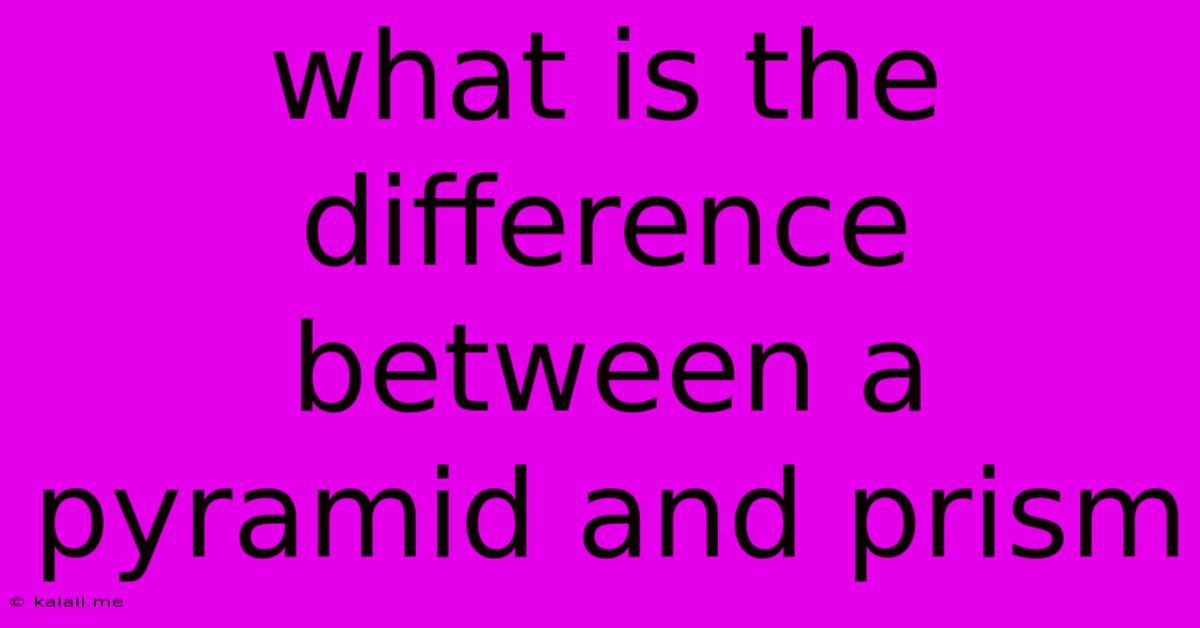What Is The Difference Between A Pyramid And Prism
Kalali
Jun 11, 2025 · 3 min read

Table of Contents
What's the Difference Between a Pyramid and a Prism? A Comprehensive Guide
Understanding the differences between pyramids and prisms is crucial for anyone studying geometry, architecture, or even just appreciating the beauty of shapes in the world around us. While both are three-dimensional solids with flat polygonal faces, they differ significantly in their base and overall structure. This article will delve into the key distinctions between pyramids and prisms, making the concepts clear and easy to grasp.
What is a Pyramid?
A pyramid is a three-dimensional geometric shape that has a polygonal base and triangular lateral faces that meet at a single point called the apex or vertex. Imagine a triangle sitting on a square base; that's essentially a square pyramid. The number of sides on the base dictates the number of triangular faces. For example, a triangular pyramid has a triangular base and three triangular faces, while a pentagonal pyramid boasts a pentagonal base and five triangular faces. The slant height is the distance from the apex to the midpoint of any base edge. Pyramids can be right pyramids (where the apex is directly above the center of the base) or oblique pyramids (where the apex is not directly above the center).
Key Characteristics of a Pyramid:
- Polygonal Base: The foundation of the pyramid, which can be any polygon (triangle, square, pentagon, etc.).
- Triangular Lateral Faces: These faces connect the base to the apex.
- Single Apex: The point where all the triangular faces meet.
- Slant Height: The distance from the apex to the midpoint of a base edge.
- Height: The perpendicular distance from the apex to the base.
What is a Prism?
A prism, unlike a pyramid, is a three-dimensional shape with two identical and parallel polygonal bases connected by rectangular lateral faces. Think of a rectangular box; that's a rectangular prism. The bases are congruent and parallel, and the lateral faces are parallelograms. Prisms, just like pyramids, can be classified based on the shape of their base, such as triangular prisms, rectangular prisms, or hexagonal prisms. Similar to pyramids, prisms can also be described as right prisms (where the lateral faces are perpendicular to the base) or oblique prisms (where the lateral faces are not perpendicular to the base).
Key Characteristics of a Prism:
- Two Congruent and Parallel Bases: These bases are identical in shape and size and are parallel to each other.
- Parallelogram Lateral Faces: The faces connecting the two bases are parallelograms (in a right prism, these are rectangles).
- Uniform Height: The perpendicular distance between the two bases remains constant throughout.
Comparing Pyramids and Prisms: A Table Summary
| Feature | Pyramid | Prism |
|---|---|---|
| Base | One polygonal base | Two congruent and parallel polygonal bases |
| Lateral Faces | Triangular faces | Parallelogram faces |
| Apex | Single apex | No apex |
| Shape | Tapering shape | Uniform shape |
| Volume Calculation | More complex formula | Relatively simpler formula |
Real-world examples:
- Pyramids: The Great Pyramids of Giza, a stack of sugar cubes arranged to form a point.
- Prisms: A building block, a box of cereal, a crystal.
By understanding these key differences, you can confidently identify and differentiate between pyramids and prisms in any context. Their distinct characteristics make them fascinating subjects of study in geometry and design, and understanding their unique properties opens doors to a deeper appreciation of three-dimensional shapes and their applications in the real world.
Latest Posts
Latest Posts
-
What Is The Opposite Of Dawn
Jun 12, 2025
-
Difference Between Subsistence And Commercial Farming
Jun 12, 2025
-
The Teacher Of Alexander The Great
Jun 12, 2025
-
How Many Microns Are In A Meter
Jun 12, 2025
-
How Do I Spell The Number 90
Jun 12, 2025
Related Post
Thank you for visiting our website which covers about What Is The Difference Between A Pyramid And Prism . We hope the information provided has been useful to you. Feel free to contact us if you have any questions or need further assistance. See you next time and don't miss to bookmark.